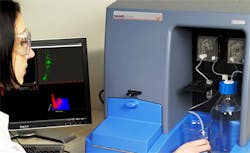ASTM publishes Nanoparticle Tracking Analysis standard for nanoparticle size distribution
Salisbury, England--Nanoparticle characterization company NanoSight announced that the American Society of Testing Materials (ASTM; www.astm.org) has published ASTM E2834 - Standard Guide for Measurement of Particle Size Distribution of Nanomaterials in Suspension by Nanoparticle Tracking Analysis (NTA) (see www.astm.org/Standards/E2834.htm). The standard details application of Nanoparticle Tracking Analysis (NTA) to measurement of particle size distributions for suspended particles from approximately 10 nm to the onset of sedimentation.
Duncan Griffiths, NanoSight's USA West sales manager, said, "This document has taken almost three years to develop. It provides a rigorous review of the core science driving Brownian motion and the derived parameters of mean, mode, percentile values and concentration. The scrutiny of demanding third-party experts has been fundamental in producing a thorough appraisal of NTA. The result is a meticulous presentation of science and methodology."
The UK's National Physical Laboratory (NPL) has seen NanoSight develop NTA since its early days more than five years ago. Helen Sharman from NPL said, "NPL has been working on the characterization of nanomaterials for many years, in-part collaborating with NanoSight. The nanomaterials team has followed the development of the NTA technique with great interest due to its unique capability in the area of nanometrology. As the UK's national measurement institute, NPL recognizes the importance of this standard and the capability of the NanoSight instrumentation to provide consistent, precise and comparable data."
NanoSight CEO Jeremy Warren adds, "Whilst this standard is a milestone, it is also a building block. Many NanoSight users have requested this definition of the technique as they present data in research papers and to regulatory bodies for product approvals and clinical trials. We will now move to provide industry with test methods for specific materials to help lock down SOPs. The timing of this publication is helpful as the European Commission move to consider methodologies to address the characterization challenges of their recently-published definition of nanomaterials. Here we see a significant role for NTA's unique nanoparticle counting capability."
SOURCE: NanoSight; www.nanosight.com
IMAGE:Nanoparticle Tracking Analysis software runs on the NanoSight NS500 to characterize nanoparticle size distribution. (Courtesy NanoSight)
